Oki C5600 User Manual
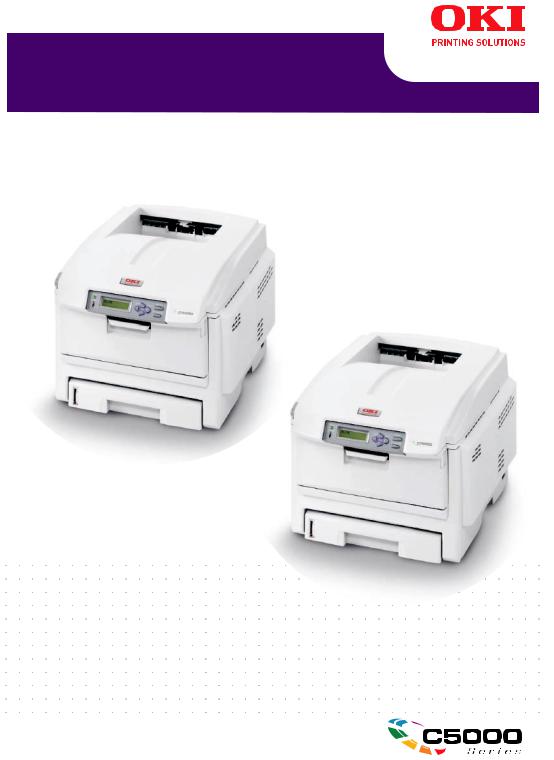
C5600/C5800
User’s Guide

PREFACE
Every effort has been made to ensure that the information in this document is complete, accurate, and up-to-date. The manufacturer assumes no responsibility for the results of errors beyond its control. The manufacturer also cannot guarantee that changes in software and equipment made by other manufacturers and referred to in this guide will not affect the applicability of the information in it. Mention of software products manufactured by other companies does not necessarily constitute endorsement by the manufacturer.
While all reasonable efforts have been made to make this document as accurate and helpful as possible, we make no warranty of any kind, expressed or implied, as to the accuracy or completeness of the information contained herein.
The most up-to-date drivers and manuals are available from the Oki Europe website:
http://www.okiprintingsolutions.com
Copyright © 2006. All rights reserved.
Oki and Microline are registered trademarks of Oki Electric Industry Company, Ltd.
Energy Star is a trademark of the United States Environmental Protection Agency.
Hewlett-Packard, HP, and LaserJet are registered trademarks of Hewlett-Packard Company.
Microsoft, MS-DOS and Windows are registered trademarks of Microsoft Corporation.
Apple, Macintosh, Mac and Mac OS are registered trademarks of Apple Computer.
Other product names and brand names are registered trademarks or trademarks of their proprietors.
As an Energy Star Program Participant, the manufacturer has determined that this product meets the Energy Star guidelines for energy efficiency.
This product complies with the requirements of the Council Directives 89/336/EEC (EMC) and 73/23/EEC (LVD) as amended where applicable on the approximation of the laws of the member states relating to electromagnetic compatibility and low voltage.
Please note that Microsoft Windows XP was used to produce all screenshots in this manual. These screenshots may vary if you are using any other operating system, but the principle is the same.
Preface> 2
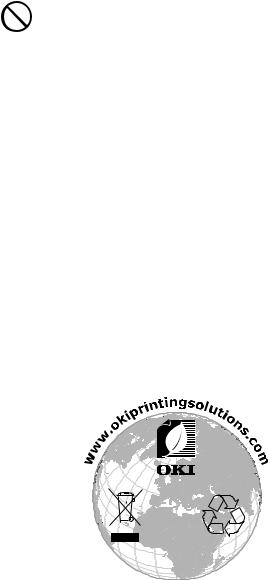
EMERGENCY FIRST AID
Take care with toner powder:
If swallowed, induce vomiting and seek medical attention. Never attempt to induce vomiting if person is unconscious.
If inhaled, move the person to an open area for fresh air. Seek medical attention.
If it gets into the eyes, flush with large amounts of water for at least 15 minutes keeping eyelids open. Seek medical attention.
Spillages should be treated with cold water and soap to help reduce risk of staining skin or clothing.
IMPORTER TO THE EU
Oki Europe Limited (trading as OKI Printing Solutions)
Central House
Balfour Road Hounslow TW3 1HY
United Kingdom
For all sales, support and general enquiries contact your local distributor.
ENVIRONMENTAL INFORMATION
Emergency First Aid> 3
CONTENTS
Preface . . . . . . . . . . . . . . . . . . . . . . . . . . . . . . . . . . 2 Emergency First Aid . . . . . . . . . . . . . . . . . . . . . . . . 3 Importer to the EU . . . . . . . . . . . . . . . . . . . . . . . . . 3 Environmental Information . . . . . . . . . . . . . . . . . . 3 Contents . . . . . . . . . . . . . . . . . . . . . . . . . . . . . . . . . 4 Notes, Cautions and Warnings . . . . . . . . . . . . . . . . 6
Introduction . . . . . . . . . . . . . . . . . . . . . . . . . . . . . . 7
Printer overview. . . . . . . . . . . . . . . . . . . . . . . . . . 9 Changing the display language . . . . . . . . . . . . . . 11
Paper recommendations. . . . . . . . . . . . . . . . . . . . 12
Cassette trays . . . . . . . . . . . . . . . . . . . . . . . . . . 13 Multi purpose tray . . . . . . . . . . . . . . . . . . . . . . . 13 Face down stacker . . . . . . . . . . . . . . . . . . . . . . . 14 Face up stacker . . . . . . . . . . . . . . . . . . . . . . . . . 14 Duplex unit . . . . . . . . . . . . . . . . . . . . . . . . . . . . 14
Loading paper. . . . . . . . . . . . . . . . . . . . . . . . . . . . 15
Cassette trays . . . . . . . . . . . . . . . . . . . . . . . . . . 15
Printer settings in Windows . . . . . . . . . . . . . . . . . 20
Printing preferences in Windows applications. . . . . 20 Setting from Windows control panel . . . . . . . . . . . 24
Printer settings in Mac . . . . . . . . . . . . . . . . . . . . . 28
Mac OS 9 . . . . . . . . . . . . . . . . . . . . . . . . . . . . . 28 Mac OS X . . . . . . . . . . . . . . . . . . . . . . . . . . . . . 42
Colour printing . . . . . . . . . . . . . . . . . . . . . . . . . . . 59
Factors that affect the appearance of prints. . . . . . 59 Tips for printing in colour . . . . . . . . . . . . . . . . . . 61 Accessing the colour matching options . . . . . . . . . 62 Setting the colour matching options . . . . . . . . . . . 62 Using the colour swatch feature . . . . . . . . . . . . . . 64 Using the Colour Correct Utility . . . . . . . . . . . . . . 65
Menu functions . . . . . . . . . . . . . . . . . . . . . . . . . . . 66
Print jobs menu . . . . . . . . . . . . . . . . . . . . . . . . . 67 Information menu . . . . . . . . . . . . . . . . . . . . . . . 67 Shutdown menu. . . . . . . . . . . . . . . . . . . . . . . . . 67 Print menu . . . . . . . . . . . . . . . . . . . . . . . . . . . . 68 Media menu. . . . . . . . . . . . . . . . . . . . . . . . . . . . 70 Colour menu . . . . . . . . . . . . . . . . . . . . . . . . . . . 73
Contents> 4
System configuration menu . . . . . . . . . . . . . . . . . 74 USB menu. . . . . . . . . . . . . . . . . . . . . . . . . . . . . 75 Network menu . . . . . . . . . . . . . . . . . . . . . . . . . . 75 Maintenance menu . . . . . . . . . . . . . . . . . . . . . . . 76 Usage menu . . . . . . . . . . . . . . . . . . . . . . . . . . . 77
Replacing consumable items . . . . . . . . . . . . . . . . 78
Consumable order details . . . . . . . . . . . . . . . . . . 79 Toner cartridge replacement . . . . . . . . . . . . . . . . 80 Image drum replacement . . . . . . . . . . . . . . . . . . 85 Replacing the belt unit . . . . . . . . . . . . . . . . . . . . 89 Fuser replacement . . . . . . . . . . . . . . . . . . . . . . . 92 Cleaning the LED head . . . . . . . . . . . . . . . . . . . . 94
Installing upgrades . . . . . . . . . . . . . . . . . . . . . . . 95
Duplex unit . . . . . . . . . . . . . . . . . . . . . . . . . . . . 95 Memory upgrade . . . . . . . . . . . . . . . . . . . . . . . . 97 Additional paper tray . . . . . . . . . . . . . . . . . . . . .100 Adjusting Windows printer drivers . . . . . . . . . . . .101
Clearing paper jams . . . . . . . . . . . . . . . . . . . . . . 102 Specifications . . . . . . . . . . . . . . . . . . . . . . . . . . . 111 Index . . . . . . . . . . . . . . . . . . . . . . . . . . . . . . . . . 114 Oki contact details . . . . . . . . . . . . . . . . . . . . . . . 116
Contents> 5
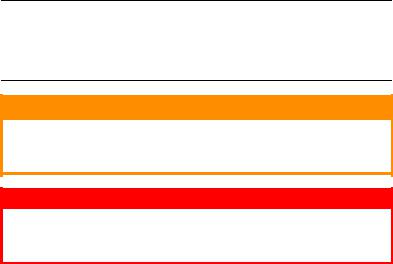
NOTES, CAUTIONS AND WARNINGS
NOTE:
A note appears in this manual like this. A note provides additional information to supplement the main text which may help you to use and understand the product.
CAUTION!
A caution appears in this manual like this. A caution provides additional information which, if ignored, may result in equipment malfunction or damage.
WARNING!
A warning appears in this manual like this. A warning provides additional information which, if ignored, may result in a risk of personal injury.
Notes, Cautions and Warnings> 6
INTRODUCTION
Congratulations on buying this Oki Printing Solutions colour printer. Your new printer is designed with advanced features to give you clear, vibrant colour prints and crisp black and white pages at high speed on a range of print media for the office.
Your printer includes these features:
>Multi-level technology produces subtler tones and smoother gradations of colour to lend photographic quality to your documents;
>Up to 20 (C5600) or 26 (C5800) pages per minute in full colour for fast printing of high impact colour presentations and other documents;
>Up to 32 pages per minute in black and white for fast and efficient printing of all general purpose documents not requiring colour;
>600 x 600, 1200 x 600 dpi (dots per inch) and 600 x 600
x2 bit print resolution for high quality image production showing the finest detail;
>Single Pass colour Digital LED technology for high speed processing of your printed pages;
>10Base-T and 100Base-TX network connection lets you share this valuable resource among users on your office network;
>Photo Enhance mode to improve printouts of photographic images;
>“Ask Oki” – a user-friendly function for Windows that gives
adirect link from your printer driver screen to a dedicated web site specific to the exact model you are using. This is where you’ll find all the advice, assistance and support you could need to help you get the best possible results from your Oki printer;
>“WebPrint Internet Explorer plugin” - another brand new function for Windows that enables you to print web pages properly;
Introduction> 7
>Internal hard disk drive (standard on “h” models, optional on others) for storage of overlays, macros and downloadable fonts, and automatic collation of multiple copies of multipage documents ;
>Template Manager 2006 utility for Windows enables the design and print of Business cards, banners, labels with ease.
Additionally, the following optional features are also available:
>External Wireless Print server available - eliminating the need for network cabling;
>Automatic two-sided (duplex) printing for economical use of paper and compact printing of larger documents (standard on dn models);
>Additional paper tray for loading a further 530 sheets to minimise operator intervention, or different paper stocks for letterhead stationery, alternative paper sizes or other print media;
>Additional memory allows printing of more complex pages. For example, high resolution banner printing;
>Storage Cabinet.
Introduction> 8
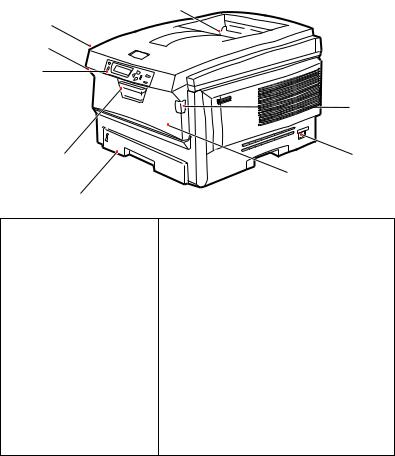
PRINTER OVERVIEW
FRONT VIEW
|
|
1 |
|
|
8 |
|
|
|
7 |
|
|
|
2 |
|
|
|
|
|
7 |
|
6 |
|
5 |
|
|
|
4 |
|
3 |
|
|
1. |
Output stacker, face |
4. |
Multi purpose tray (80g/m²). |
|
down. |
|
Used for feeding heavier paper |
|
|
|
|
|
Standard printed copy |
|
stocks, envelopes and other special |
|
delivery point. Holds |
|
media. Also for manual feeding of |
|
up to 250 sheets at |
|
single sheets when required. |
|
80g/m². |
5. |
ON/OFF switch. |
|
|
||
2. |
Operator panel. |
6. Front cover release lever. |
|
|
|
||
|
Menu driven operator |
7. Multi-purpose tray release lever |
|
|
controls and LCD |
||
|
8. |
Top cover release button. |
|
|
display panel. |
||
3. |
Paper tray. |
|
|
|
Standard blank paper |
|
|
|
tray. Holds up to 300 |
|
|
|
sheets of 80g/m² |
|
|
|
paper. |
|
|
The LCD display language can be changed to show different languages. (See “Changing the display language” on page 11.)
Introduction> 9
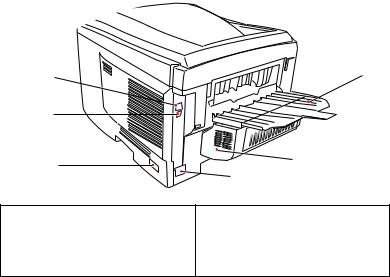
REAR VIEW
This view shows the connection panel, the rear output stacker and the location of the optional duplex (two-sided printing) unit.
9 |
|
12 |
|
|
|
10 |
|
|
5 |
|
11 |
|
|
|
|
|
8 |
5. ON/OFF switch. |
10. |
Network interface.* |
8. AC power socket. |
11. |
Duplex unit (when fitted). |
9. USB interface. |
12. |
Rear, face up, 100 sheet |
|
stacker. |
|
* The Network Interface has a protective “plug” which must be removed before connection can be made.
When the rear paper stacker is folded down paper exits the printer through the rear of the printer and is stacked here face up. This is mainly used for heavy print media. When used in conjunction with the multi purpose feed tray, the paper path through the printer is essentially straight. This avoids bending the paper around curves in the paper path and enables feeding of up to 203g/m² media.
Introduction> 10
CHANGING THE DISPLAY LANGUAGE
The default language used by your printer for display messages and for report printing is English. If required, this can be changed to:l
German |
Danish |
French |
Dutch |
Italian |
Turkish |
Spanish |
Portuguese |
Swedish |
Polish |
Russian |
Greek |
Finnish |
Czech |
Hungarian |
Norwegian |
See the information enclosed with the printer on the procedure for changing the language setting.
Introduction> 11
PAPER RECOMMENDATIONS
Your printer will handle a variety of print media, including a range of paper weights and sizes, transparencies and envelopes. This section provides general advice on choice of media, and explains how to use each type.
The best performance will be obtained when using standard 75~90g/m² paper designed for use in copiers and laser printers. Suitable types are:
•Arjo Wiggins Conqueror Colour Solutions 90g/m²;
•Colour Copy by Neusiedler.
Use of heavily embossed or very rough textured paper is not recommended.
Pre-printed stationery can be used, but the ink must not offset when exposed to the high fuser temperatures used in the printing process.
Envelopes should be free from twist, curl or other deformations. They should also be of the rectangular flap type, with glue that remains intact when subjected to hot roll pressure fusing used in this type of printer. Window envelopes are not suitable.
Transparencies should be of the type designed for use in copiers and laser printers. We strongly recommend Oki Printing Solutions transparencies (Order No. 01074101). In particular, avoid office transparencies designed for use by hand with marker pens. These will melt in the fuser and cause damage.
Labels should also be of the type recommended for use in copiers and laser printers, in which the base carrier page is entirely covered by labels. Other types of label stock may damage the printer due to the labels peeling off during the printing process. Suitable types are:
•Avery White Laser Label types 7162, 7664, 7666 (A4), or 5161 (Letter);
Paper recommendations> 12

CASSETTE TRAYS
SIZE |
DIMENSIONS |
|
A6 (Tray 1 |
105 x 148mm |
|
only) |
||
|
||
|
|
|
A5 |
148 x 210mm |
|
B5 |
182 x 257mm |
|
|
|
|
Executive |
184.2 x 266.7mm |
|
A4 |
210 x 297mm |
|
|
|
|
Letter |
215.9 x 279.4mm |
|
Legal 13in. |
216 x 330mm |
|
|
|
|
Legal 13.5in. |
216 x 343mm |
|
Legal 14in. |
216 x 356mm |
WEIGHT (G/M²)
Light 64-74g/m² Medium 75-90g/m² Heavy 91-120g/m²
Ultra heavy121-176g/m² (Tray 2 only)
If you have identical paper stock loaded in another tray (2nd tray if you have one, or multi purpose tray) you can have the printer automatically switch to the other tray when the current tray runs out of paper. When printing from Windows applications, this function is enabled in the driver settings. (See “Printer Settings in Windows” later in this guide.) When printing from other systems, this function is enabled in the Print Menu. (See “Menu Functions” later in this guide.)
MULTI PURPOSE TRAY
The multi purpose tray can handle the same sizes as the cassette trays but in weights up to 203g/m². For very heavy paper stock use the face up (rear) paper stacker. This ensures that the paper path through the printer is almost straight.
The multi purpose tray can feed paper widths as small as 100mm and lengths up to 1200mm (banner printing).
For paper lengths exceeding 356mm (Legal 14in.) use paper stock between 90g/m² and 128g/m² and the face up (rear) paper stacker.
Use the multi purpose tray for printing on envelopes and transparencies. Up to 50 sheets of transparencies or 10 envelopes can be loaded at one time, subject to a maximum stacking depth of 10mm.
Paper or transparencies should be loaded print side up and top edge into the printer. Do not use the duplex (two-sided printing) function.
Paper recommendations> 13

FACE DOWN STACKER
The face down stacker on the top of the printer can hold up to 250 sheets of 80g/m² standard paper, and can handle paper stocks up to 176g/m². Pages printed in reading order (page 1 first) will be sorted in reading order (last page on top, facing down).
FACE UP STACKER
The face up stacker at the rear of the printer should be opened and the tray extension pulled out when required for use. In this condition paper will exit via this path, regardless of driver settings.
The face up stacker can hold up to 100 sheets of 80g/m² standard paper, and can handle stocks up to 203g/m².
Always use this stacker and the multi purpose feeder for paper stocks heavier than 176g/m².
DUPLEX UNIT
This option provides automatic two-sided printing on the same range of paper sizes as tray 2 (i.e. all cassette sizes except A6), using paper stocks from 75-105g/m².
NOTE:
The duplex unit comes as standard with dn models.
Paper recommendations> 14
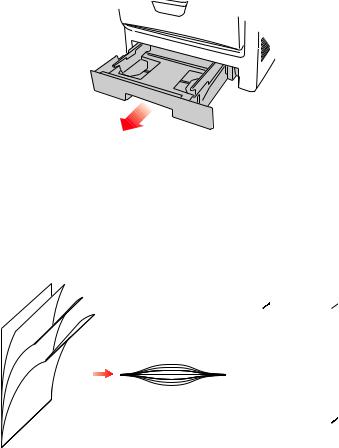
LOADING PAPER
CASSETTE TRAYS
1.Remove the paper tray from the printer.
2.Fan the paper to be loaded at the edges (1) and in the middle (2) to ensure that all sheets are properly separated, then tap the edges of the stack on a flat surface to make it flush again (3).
|
|
|
|
|
|
|
|
|
|
|
|
|
|
|
|
|
|
|
|
2 |
|
|
3 |
|
Loading paper> 15
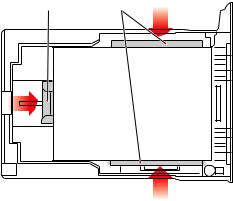
3.Load letter headed paper face down and top edge towards the front of the printer, as shown.
1 2
4.Adjust the rear stopper (1) and paper guides (2) to the size of paper being used.
To prevent paper jams:
•Do not leave space between the paper and the guides and rear stopper.
•Do not overfill the paper tray. Capacity depends on the type of paper stock.
•Do not load damaged paper.
•Do not load paper of different sizes or types at the same time.
•Do not pull the paper tray out during printing (except as described below for the 2nd tray).
•Close the paper tray gently.
5.If you have two trays and you are printing from the 1st (upper) tray, you can pull out the 2nd (lower) tray during printing to reload it. However, if printing from the 2nd (lower) tray, do not pull out the 1st (upper) tray. This will cause a paper jam.
Loading paper> 16
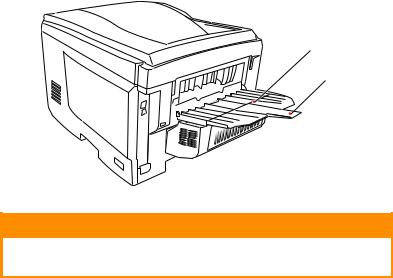
6.For face down printing, make sure the face up (rear) stacker (3) is closed (the paper exits from the top of the printer). Stacking capacity is approximately 250 sheets, depending on paper weight.
7.For face up printing, make sure the face up (rear) stacker (3) is open and the paper support (4) is extended. Paper is stacked in reverse order and tray capacity is approximately 100 sheets, depending on paper weight.
8.Always use the face up (rear) stacker for heavy paper (card stock etc.).
3
4
CAUTION!
Do not open or close the rear paper exit while printing as it may result in a paper jam.
Loading paper> 17
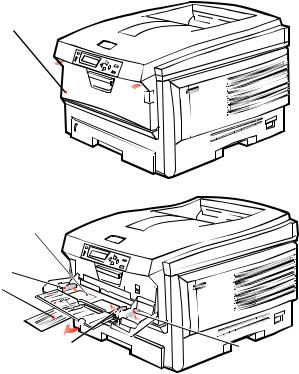
MULTI PURPOSE TRAY
1.Open the multi purpose tray (1).
2.Fold out the paper supports (2).
1
3
4
2

4 |
5 |
|
3.Press gently down on the paper platform (3) to ensure it is latched down.
4.Load the paper and adjust the paper guides (4) to the size of paper being used.
•For single-sided printing on headed paper load the paper into the multi purpose tray with pre-printed side up and top edge into the printer.
Loading paper> 18
•For two-sided (duplex) printing on headed paper load the paper with pre-printed side down and top edge away from the printer. (Optional duplex unit must be installed for this function.)
•Envelopes should be loaded face up with top edge to the left and short edge into the printer. Do not select duplex printing on envelopes.
•Do not exceed the paper capacity of about 50 sheets or 10 envelopes. Maximum stacking depth is 10mm.
5.Press the tray latch button (5) inwards to release the paper platform, so that the paper is lifted and gripped in place.
Set the correct paper size for the multi purpose tray in the Media Menu (see “Menu Functions”).
Loading paper> 19
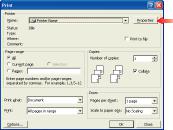
PRINTER SETTINGS IN WINDOWS
Your printer’s operator panel menus provide access to many options.
The Windows printer driver also contains settings for many of these items. Where items in the printer driver are the same as those in the operator panel menus, and you print documents from Windows, the settings in the Windows printer driver will override those items in the operator panel menus.
The illustrations in this chapter show Windows XP. Other Windows versions may appear slightly different, but the principles are the same.
PRINTING PREFERENCES IN WINDOWS APPLICATIONS
When you choose to print your document from a Windows application program a print dialogue box appears. This dialogue usually specifies the name of the printer on which you will print your document. Next to the printer name is a Properties button.
When you click Properties a new
window opens which contains a short list of the printer settings available in the driver, which you can choose for this document.
The settings available from within your application are only those which you may want to change for specific applications or documents. Settings you change here will usually only last for as long as the particular application program is running.
Printer settings in Windows> 20
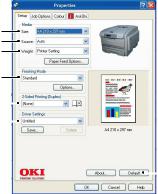
SETUP TAB
When you click the Properties button from your application’s Print dialogue, the driver window opens to allow you to specify your printing preferences for the current document.
1
2
3
4
1. |
Paper size should be the |
5 |
|
|
|
|
|
|
|
|
|||
6 |
|
|
|
|
||
|
same as the page size of |
|
|
|
|
|
|
|
|
|
|
||
|
|
|
|
|
|
|
|
your document (unless |
|
|
|
|
|
|
you wish to scale the |
|
|
|
|
|
|
printout to fit another |
|
|
|
|
7 |
|
|
size), and should also be the same as the size of
paper you will feed into the printer.
2.You can choose the source of the paper to feed, which may be Tray 1 (the standard paper tray), Tray 2 (if you have the optional 2nd paper tray installed) or the multi purpose feeder. You can also click on the appropriate part of the screen graphic to select your preferred tray.
3.The setting for paper weight should match the type of paper on which you intend to print.
4.A variety of document finishing options can be selected, such as normal one page per sheet, or N-up (where N can be any number up to 16) for printing scaled down pages at more than one page per sheet. Booklet printing prints two pages per sheet on each side of the paper so that when folded they make up a booklet. Booklet printing requires the duplex unit to be installed in your printer.
Poster printing will print large pages as tiles spread over multiple sheets.
5.For two-sided printing, you can choose to flip the page by the long edge or the short edge. Of course, this requires that a duplex unit be installed in your printer.
6.If you have changed some printing preferences before and saved them as a set, you can recall them to avoid having to set them individually each time you need them.
7.A single on-screen button restores the default settings.
Printer settings in Windows> 21
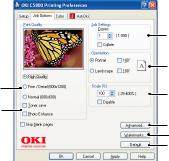
JOB OPTIONS TAB
3
4
1
5
8
6
2
7
1.The output resolution of the printed page can be set as follows.
•The High Quality setting prints at 600 x 600dpi x 2 bit. This option requires the most printer memory and takes the longest to print.
•The Fine/Detail setting prints at 1200 x 600dpi and is adequate for all but the most discerning applications.
•The Normal setting prints at 600 x 600dpi and is suitable for mostdraft documents, where print quality is less critical.
2.You can print watermark text behind the main page image. This is useful for marking documents as draft, confidential, etc.
3.You can select up to 999 copies to print consecutively, although you will need to top up the paper tray during such a long print run.
4.Page orientation can be set to either portrait (tall) or landscape (wide).
5.You printed pages can be scaled to fit larger or smaller stationery.
6.Clicking the Advanced button gives you access to further settings. For example, you can elect to have black areas printed using 100%K toner (a more matte appearance).
7.A single on-screen button restores the default settings.
8.The quality of photographic images can be improved.
Printer settings in Windows> 22
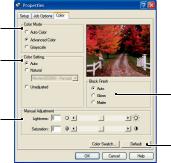
COLOUR TAB
1
2
4
3
5
1.Control over the colour output of your printer may be performed automatically, or for advanced control, by manual adjustment. The automatic setting will be appropriate in most cases. The other options in this window only become visible when you select a choice other than Auto. For greyscale printing, the printer runs at 24ppm and all pages are printed in black and white.
2.You can choose from a range of colour matching options, depending on the image source for your document. For example, a photograph taken on a digital camera might require different colour matching to a business graphic created in a spreadsheet application. Again, for most general purpose use, automatic is the best choice.
3.Printed output may be made lighter or darker, or the colours made more saturated and vibrant as required.
4.Black areas may be printed using 100% cyan, magenta and yellow (composite black), giving a more glossy appearance, or using only black toner (true black), giving a more matte appearance. Choosing the automatic setting allows the driver to make the most appropriate choice depending on image content.
5.A single on-screen button restores the default settings.
Printer settings in Windows> 23
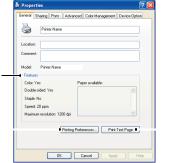
SETTING FROM WINDOWS CONTROL PANEL
When you open the driver properties window directly from Windows, rather than from within an application program, a somewhat more extensive range of settings is provided. Changes made here will generally affect all documents you print from Windows applications, and will be remembered from one Windows session to the next.
GENERAL TAB
1
2 |
|
|
|
3 |
|
|
1.This area lists some of the main features of your printer, including optional items, such as duplex (two-sided) printing.
2.This button opens the same windows as described earlier for items which can be set from within application programs. Changes you make here, however, will become the new default settings for all Windows applications.
3.This button prints a test page to ensure that your printer is working.
Printer settings in Windows> 24
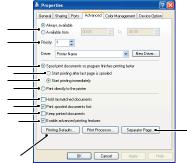
ADVANCED TAB
1
2
3
54
6
7
98
10
12
11
1.You can specify which times of day your printer will be available.
2.Indicates current priority, from 1 (lowest) to 99 (highest). Highest priority documents will print first.
3.Specifies that documents should be spooled (stored in a special print file) before being printed. The document is then printed in the background, allowing your application program to become available more quickly.
4.This specifies that printing should not start until the last page has been spooled. If your application program needs a lot of time for further computation in the middle of printing, causing the print job to pause for more than a short period, the printer could prematurely assume that the document has finished. Selecting this option would prevent that situation, but printing will be completed a little later, as the start is delayed.
5.This is the opposite choice to the one above. Printing starts as soon as possible after the document begins spooling.
6.This specifies that the document should not be spooled, but printed directly. Your application will not normally be ready for further use until the print job is complete. This requires less disk space on your computer, since there is no spool file.
Printer settings in Windows> 25
7.Directs the spooler to check the document setup and match it to the printer setup before sending the document to print. If a mismatch is detected, the document is held in the print queue and does not print until the printer setup is changed and the document restarted from the print queue. Mismatched documents in the queue will not prevent correctly matched documents from printing.
8.Specifies that the spooler should favour documents which have completed spooling when deciding which document to print next, even if completed documents are lower priority than documents which are still spooling. If no documents have completed spooling, the spooler will favour larger spooling documents over shorter ones. Use this option if you want to maximise printer efficiency. When this option is disabled the spooler chooses documents based only on their priority settings.
9.Specifies that the spooler should not delete documents after they are completed. This allows documents to be re submitted to the printer from the spooler instead of printing again from the application program. If you use this option frequently it will require large amounts of disk space on your computer.
10.Specifies whether advanced features, such as booklet printing, page order and pages per sheet, are available, depending on your printer. For normal printing keep this option enabled. If compatibility problems occur you can disable the feature. However, these advanced options may then not be available, even though the hardware might support them.
11.This button provides access to the same setup windows as when printing from applications. Changes made via the Windows Control Panel become the Windows default settings.
12.You can design and specify a separator page that prints between documents. This is particularly useful on a shared printer to help each user find their own documents in the output stack.
Printer settings in Windows> 26
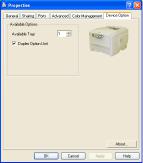
DEVICE OPTIONS TAB
In this window you can select which optional upgrades are installed on your printer. This is covered in more detail in the section in this guide about installing upgrades.
Printer settings in Windows> 27
PRINTER SETTINGS IN MAC
MAC OS 9
CHOOSING PRINTING OPTIONS
Use the print dialog to choose your printer and select options for how you want your document to print.
1.Open the document you want to print.
2.If you wish to change the paper size or page orientation, choose File > Page Setup.
The Page Setup options are described commencing page 29.
3.Choose File > Print.
4.Select your printer from the Printer pop-up menu.
5.If you wish to change any printer driver settings, select the necessary options in the print dialog. You can select more options from the Copies & Pages menu.
The printer driver options are described commencing page 29.
6.Click Print.
CHANGING THE DEFAULT PRINT SETTINGS
If you print a document and change the printer driver settings, these changes are only remembered for that particular document. To change the printer driver settings for all future print jobs:
1.Select Apple menu > Chooser.
2.Select your printer driver in the left-hand panel of the Chooser window.
3.Select your printer model in the right-hand panel of Chooser.
Printer settings in Mac> 28
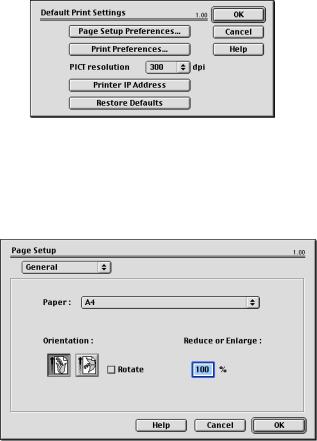
4.Click Preferences.
5.Change Page Setup Preferences or Print Preferences as required.
These new settings will be saved as the printer driver defaults.
PAGE SETUP OPTIONS - GENERAL
Paper
Choose the paper size that matches your document and the paper loaded in the printer. The paper margin is 1/6 inch (4.2 mm) at all edges.
Orientation
Selects either portrait (tall) or landscape (wide).
If using landscape, you can flip the orientation 180 degrees.
Printer settings in Mac> 29

Reduce or Enlarge
Documents can be scaled up or down to fit on different paper sizes.
PAGE SETUP OPTIONS - LAYOUT
Multiple pages can be shrunk and printed on a single sheet of paper. For example, choosing 4-up will tile four of your document's pages across a single sheet of paper.
You can control the order in which the documents are tiled and also choose to surround each document page with a border.
Duplex
If you have an optional duplex unit fitted to your printer, you can print on both sides of the paper.
Long-Edge Binding prints pages that read like a normal book. Short-edge Binding prints pages that read like a notepad.
Printer settings in Mac> 30
